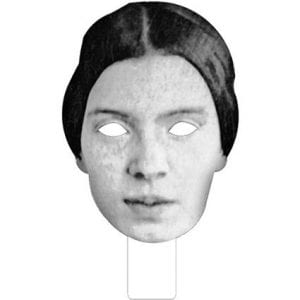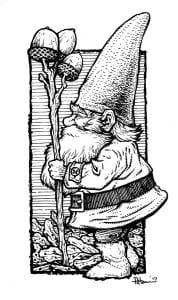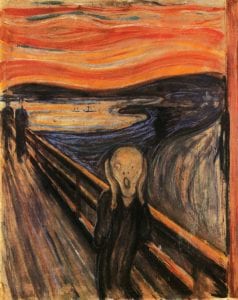On Choosing the Poems
 Sometime in Spring 1876, Dickinson wrote to Thomas Wentworth Higginson and included these words on a separate page:
Sometime in Spring 1876, Dickinson wrote to Thomas Wentworth Higginson and included these words on a separate page:
Nature is a Haunted House – but Art – a House that tries to be Haunted. (L459a)
Many scholars take this as a statement of her poetic philosophy, but what does it mean?
Daneen Wardrop links this assertion to Dickinson’s “feminine gothic,” a poetic sensibility that “builds her poetic house full of liminal spaces,” windows, doors, caves, caverns, cellars and corridors and their metaphorical equivalents. And especially door jambs, the setting of so many of Dickinson’s “sceneless” poems and the central gesture of the female gothic writer—the locus of hesitation or uncertainty:
On the imagistic level, the doorjamb provides the perfect liminal space of hesitation; in gothic terms, it provides the ultimate architectural location where victim and victimizer meet; culturally, it forms the bride’s threshold; in Freudian terms, it locates a highly charged space to which no woman can be indifferent [concerning her sexual availability].
Many theories of the gothic turn on Freud’s essay “The Uncanny,” (1919), a reading of E.T.A. Hoffmann’s (1776-1822) short story “The Sandman” (1817) with its palpable sense of the “strangely familiar” that centers on a mechanical life-sized doll called Olympia. However, Wardrop finds a female gothic in French feminist Hélène Cixous’s revision of Freud.

Cixous argues that women write from the margins, that they “animate Olympia” and write and read from her position, producing a literature of “failed repression and recurrent reevaluation.” Wardrop is most interested in the “metagothic,” literature that comments ironically on itself, as we see Dickinson doing constantly. And what she comments on, according to Wardrop, is “the program of unboxing women,” using the techniques of hesitation, suspense, awe, fear and appeal to the emotions:
Dickinson works to animate Olympia by rediscovering the possibilities for her own gothic house, body, text.
An important element in Dickinson’s technique is her gothic syntax, which Wardrop describes as
that alien environment always “ajar,” to use one of the poet’s prominent words – the syntax that also jars the reader’s sense of reality. Whereas reader hesitation occurs in fiction on the narrative level, in the lyric it more often occurs on the syntactic level.
For Christina Pugh, not just syntax but meter also constitutes another “ghost” haunting our reading of Dickinson’s canon. Pugh argues against materialist readings of Dickinson’s poetry that ignore their sound, and invokes Freud’s notion of “the uncanny” to suggest:
Through particular extra-syntactic strategies, Dickinson highlights the uncanny potential that already uniquely resides within the shorter meters, due to their association with unrealized beats … Freud’s notion of the uncanny as residing between the animate and the inanimate (and home and not-home) becomes perfectly germane here since unrealized beats exemplify “something repressed which recurs” … In her poems, the instinctual pulse of the four-beat line becomes the ground against which not only hesitation, but genuine metrical undecidability is posited.
Finally, Wardrop suggests that Emily Dickinson’s contribution to American letters involves her ability to “transport” rather than to “transcend.” We will see a lot of transport in the poems selected for this week. In our post on the Azarian School, we looked at several of Dickinson’s more famous gothic creations, such as “After great pain, a formal / feeling comes –” (F372, J341), “’Twas like a Maelstrom, with / a notch” (F425, J414),” and “Because I could not / stop for Death–” (F479, J712). Earlier, we also looked at the key poem for this theme, “One need not be a chamber – to be Haunted–” (F407, J670) and the posthumous narrative of “’Twas just this time, last year, I died” (F344, J445). This week, we select some of Dickinson’s less well-known haunted poems, centered around the masterpiece, “I felt a Funeral in my brain.”
Alone I cannot be (F303, J298)
Alone, I cannot be –
The Hosts – do visit me -
Recordless Company -
Who baffle Key -
They have no Robes, nor Names –
No Almanacs – nor Climes –
But general Homes
Like Gnomes –
Their Coming, may be known
By Couriers within -
Their going – is not -
For they're never gone –
EDA manuscript: Originally in Poems: Packet XX, Fascicle 10. Includes 13 poems, written in ink, ca. 1861, Houghton Library – (112c). Courtesy of Houghton Library, Harvard University, Cambridge, Mass. First published in Bianchi, Emily Dickinson Face to Face: Unpublished Letters with Notes and Reminiscences (1932), 255-56, as having been sent to Susan Dickinson.

Dickinson copied this poem into Fascicle 12 in the 20th position in early 1862. It was sent to Susan Dickinson, who shared Dickinson’s fascination with Gothic tales of hauntings and apparitions. Scholars have associated it with Dickinson’s fascination with spiritualism, a movement that swept through the United States and England beginning in the 1850s.
Sharon Leiter reads this poem as an exploration of Dickinson’s choice to withdraw from the social whirl of Amherst and entertain the “hosts” or “masses” of poetic inspirations, like muses, that visited her daily during this period of intense creativity. Her reading turns on the line “general Homes / Like Gnomes–.” According to Dickinson’s Webster’s Dictionary, a gnome is
An imaginary being, supposed by the cabalists to inhabit the inner parts of the earth, and to be the guardian of mines, quarries, &c.
Associated with “the inner world and its buried riches,” gnome was the word Dickinson used to sign her letters to Thomas Wentworth Higginson, “Your Gnome.” (see Letter 280, February 1863) For Leiter,
the phrase is striking for its linking of domestic and mythic imagery.
 But Leiter ignores the gothicism of the phrase and the poem’s description of visitation by bodiless beings and mysterious demonic forces. In the essay, “The Uncanny,” (1919), Sigmund Freud highlights the importance of inversions and doubling in this experience and specifically notes a “host” who becomes “uncanny.” The word “host” is inside the word “ghost,” and the very definition of uncanny derives from the turning of a host of hospitality or homeliness into a dreadful or fearful victimizer or strange spirit. “Hosts” also refers to the army of angels mentioned in the Bible, doing heavenly battle.
But Leiter ignores the gothicism of the phrase and the poem’s description of visitation by bodiless beings and mysterious demonic forces. In the essay, “The Uncanny,” (1919), Sigmund Freud highlights the importance of inversions and doubling in this experience and specifically notes a “host” who becomes “uncanny.” The word “host” is inside the word “ghost,” and the very definition of uncanny derives from the turning of a host of hospitality or homeliness into a dreadful or fearful victimizer or strange spirit. “Hosts” also refers to the army of angels mentioned in the Bible, doing heavenly battle.
Finally, the syntax and meter exemplify the disturbed, ghostly aspects of the gothic noted by Wardrop and Pugh in the introduction to this week's poems. We are lulled into a rhythm by the trimeter lines, then dropped precipitously into a dimeter line: “Who baffle Key–” and we are indeed baffled. Line 8 is even shorter, a monometer line, to imitate the “gnomic” or riddling character of these visitations, and of the speaker as well. In the last stanza, line 11 seems to be missing some phrase in the middle and the last line hardly scans at all.
Sources
Freud, Sigmund. “The Uncanny.” The Standard Edition of the Complete Works of Sigmund Freud. Translated by James Strachey. vol. XVII. London: Hogarth Press, 1948: 218- 252, 239.
Lease, Benjamin. “Spiritualism, as Influence.” An Emily Dickinson Encyclopedia. Ed. Jane Donahue Eberwein. Westport, CT.: Greenwood Press, 1998, 268-69.
Leiter, Sharon. Critical Companion to Emily Dickinson: A Literary Reference to her Life and Work. New York: Facts on File, 2007, 34-35.
You see I cannot see – your lifetime (F313, J253)
You see I cannot see – your
lifetime –
I must guess –
How many times it ache for
me – today – Confess –
How many times for my far
sake
The brave eyes film –
But I guess guessing hurts –
Mine – get so dim!
Too vague – the face –
My own – so patient – covets –
Too far – the strength –
My timidness enfolds –
Haunting the Heart –
Like her translated faces –
Teazing the want –
It – only – can suffice!
EDA manuscript: Originally in Poems: Packet X, Mixed Fascicles. Includes 14 poems, written in ink, ca. 1858-1862, Houghton Library – (46a). Courtesy of Houghton Library, Harvard University, Cambridge, Mass. First published in New York Herald Tribune Books (10 March 1929), 4, and Further Poems (1929), 162, as three stanzas of 5, 5, and 8 lines; in later collections, as four quatrains.
Dickinson copied this poem into Fascicle 13 in the 3rd position in early 1862. It is a free-verse poem about separated lovers haunted by the image of the absent beloved and their longing for that beloved but also by their imagination of the beloved’s frustrated longing for them (I deliberately use the plural pronoun here to avoid gendered singular pronouns; for the reasons, see last week’s post on “Queer”). In this poem, frustrated desire is the force “Haunting the Heart” with ghostly apparitions of the beloved’s face and feelings, although that puts it much too neatly.
The poem works through repetition and doubling. The first line sets up a pattern: “You see I cannot see” with the you and the I in seeming opposition. But in this separation, neither can “see” the other’s “lifetime,” a word that resonates with endless waiting. Nor is there the promise of union or reunion after death, as in several other Dickinson poems. They must “guess” what the other feels. “But I guess guessing hurts,” the speaker comments, by way of apology, perhaps, for failing to live constantly in the liminal space of uncertainty. We wonder, does it hurt or not? Even the speaker’s own feelings are alien and veiled.
There are also contradictions: The speaker’s “timidness enfolds … the strength” needed to keep the “vague” “face” of the lover in mind. This drives the “haunting,” wanting to be inhabited by the lost one but consumed with the inability to maintain the vision that grows distant and feeds on surmises. The last stanza reaches a climax with the simile, “Like her translated faces–.” This could be a reference to all the other faces of lost loved ones that “haunt” the female/feminized heart, conceived in Victorian America as the repository of bereaved emotions.
The only ghost I ever saw (F331, J274)
The only Ghost I ever saw
Was dressed in Mechlin – so –
He +had no sandal on his foot -
And stepped like flakes of snow –
His +Mien, was soundless, like +the Bird –
But rapid – like the Roe -
His fashions, quaint, Mosaic –
Or haply, Mistletoe -
His conversation – seldom -
His laughter, like the Breeze
That dies away in Dimples
Among the +pensive Trees –
Our interview – was transient –
Of me, himself was shy –
And God forbid I look behind –
Since that appalling Day!
+wore + Gait– +a +smiling
EDA manuscript: Poems: Packet XIV, Mixed Fasciles. Includes 33 poems, written in ink, ca. 1860-1862, Houghton Library – (75b). Courtesy of Houghton Library, Harvard University, Cambridge, Mass. First published in Poems (1891), 191, as two eight-line stanzas, with alternatives for lines 3 and 5 ("Gait") adopted.
In early 1862, Dickinson copied this poem into Fascicle 12 in the 22nd place, just one poem after “Alone I cannot be” (F303, J298). It recounts, in arresting detail and fairly regular common meter, the speaker’s “only” sighting of a ghost.
Let’s look at the details. The ghost is explicitly gendered male but wears “Mechlin,” one of the oldest, most delicate and costly forms of bobbin lace of fine floral-patterns made in Flemish towns like Mechelen and used specifically to decorate women’s clothing. Because it was so costly, it was often bought by and presented to dignitaries. Records indicate that the English Queen Mary II purchased some in 1694, despite the prohibition against imported laces, and it was a favorite of other European monarchs. It was still being produced in Dickinson’s time, but by the early 19th century, machine made lace had replaced the handmade forms.
 This costly, aristocratic lace is part of the ghost’s “fashions, quaint, Mosaic – / Or haply, Mistletoe–” Does “Mosaic” here refer to Moses, the prophet of the Israelites who brought the Ten Commandments down from Mt. Sinai—a weighty allusion—or to looking like a mosaic, made up of smaller shapes? or both? If the former, that sits uneasily with “Mistletoe” (North American Phoradendron leucarpum), a species of parasitic plants with oval, evergreen leaves, woody stems and white berries valued by the Druids and traditionally used as a Christmas decoration under which lovers kissed. Apparently, the berries were associated with male fertility; the ancient Greeks called the plant “oak sperm” because of the milky seeds. Like Halloween, Christmas was not recognized by Protestants, though Victorian culture brought back Christmas celebrations.
This costly, aristocratic lace is part of the ghost’s “fashions, quaint, Mosaic – / Or haply, Mistletoe–” Does “Mosaic” here refer to Moses, the prophet of the Israelites who brought the Ten Commandments down from Mt. Sinai—a weighty allusion—or to looking like a mosaic, made up of smaller shapes? or both? If the former, that sits uneasily with “Mistletoe” (North American Phoradendron leucarpum), a species of parasitic plants with oval, evergreen leaves, woody stems and white berries valued by the Druids and traditionally used as a Christmas decoration under which lovers kissed. Apparently, the berries were associated with male fertility; the ancient Greeks called the plant “oak sperm” because of the milky seeds. Like Halloween, Christmas was not recognized by Protestants, though Victorian culture brought back Christmas celebrations.
So far, this ghost is a bit cross-dressed as well as high-born, associated with prohibition and fertility, Judaism and Christianity, light like snowflakes, an image Dickinson uses in “They dropped like flakes”(F545, J409) to describe the Civil War dead, silent as a bird (though birds in Dickinson are often quite noisy with song or flight), fleet like “the Roe,” a male deer, reticent though prone to laughter, and shy of the speaker, though they definitely have “an interview.” Did this ghost seek the speaker out and if so, why? Ghosts often bring messages from the dead or the other world. God forbids the speaker to “look behind,” perhaps with longing for the ghost as Orpheus, the legendary Greek poet, did with his beloved and twice lost Eurydice. Another divine prohibition. Ghosts have secret, powerful knowledge. And the speaker calls the meeting “appalling,” a strong word meaning “to depress or discourage with fear,” that hints at the “paleness” and deadliness (pall) of this enigmatic figure and the shadow it casts across the speaker’s life.
Sources
Hallen, Cynthia, ed. Emily Dickinson Lexicon. Provo, Utah: Brigham Young University, 2007.
“Mistletoe.” Encyclopedia Britannica.
Palliser, Fanny Bury. History of Lace. (S. Low, Son & Marston: 1865). Dover Publications. pp. 111–114.
Of nearness to her sundered Things (F337, J607)
Of nearness to her sundered
Things
The Soul has special times –
When Dimness – looks the Oddity –
Distinctness – easy – seems –
The Shapes we buried, dwell
about,
Familiar, in the Rooms –
Untarnished by the Sepulchre,
The Mouldering Playmate comes –
In just the Jacket that he
wore –
Long buttoned in the Mold
Since we – old mornings,
Children – played –
Divided – by a world –
The Grave yields back her
Robberies –
The Years, our pilfered Things –
Bright Knots of Apparitions
Salute us, with their wings –
As we – it were – that perished –
Themself – had just remained
till we rejoin them –
And 'twas they, and not
ourself
That mourned –
EDA manuscript: Originally in Poems: Packet XXXII, Mixed Fascicles. Includes 12 poems, written in ink, ca. 1862, Houghton Library – (171b). Courtesy of Houghton Library, Harvard University, Cambridge, Mass. First published in Atlantic Monthly, 143 (February 1929), 185, and Further Poems (1929), 104, with the alternative adopted and the last stanza in five lines (in later collections, a quatrain).
Dickinson copied this poem into Fascicle 16 in the 2nd position about summer 1862. It details the “special times” or liminal moments when, either through memory or apparition, we are close to the dead. The arresting euphemism in the first line, “her sundered Things,” is clarified in line 5 as another euphemism, “The Shapes we buried.” The speaker cannot identify the dead in clear linguistic terms—for fear of scaring them off? At these times—Samhain, Halloween, All Hallows Eve, The Mexican Day of the Dead, Judaism’s Days of Awe—the dead return with “Distinctness … Untarnished by the Sepulchre,” as the playmate of the speaker’s remembered childhood. For Helen Vendler,
Dickinson’s unerring management of the rapid flickering of consciousness between fact and regained memory, as the dead “Things” of the opening become the “Children” of the past, is the most original aspect of the poem.
Vendler also traces Dickinson’s rewriting of familiar Biblical passages into a certainty about the return of “our pilfered things”: Death as a thief in the night from 1 Thessalonians 5:2; “the dead shall be raised” from the Prophets; or ghosts “saluting” us like Gabriel at the Annunciation saluting the Virgin Mary.
As if the rising of these ghosts in all their poignant details is not enough, the truly uncanny part of the poem is the reversal of time at the end, where the dead are waiting for the living to come to them. They become the mourners of the living, whose lives in the world are so sorely diminished by the loss of these silver treasures. It is like a reverse haunting.
Cristanne Miller uses this poem to illustrate how Dickinson “disrupts metrical for syntactic organization” to achieve the uncanny affect Wardrop calls “gothic.” Stanza 3, as Dickinson wrote it, is metrically disrupted by a pattern of 7-11-7-2 syllables, with one very long line. Miller points out that this lines turns the focus from “us” to “them.” Furthermore, what we hear are lines that are metrically more regular (7-6-8-6 syllables) and can be written out as:
As we – it were – that perished –
Themself – had just remained
till we rejoin them – And 'twas they,
and not ourself That mourned -
Miller explains:
This lineation powerfully maintains a heard familiar rhythm, while structurally foregrounding the complex relationship of the living with the dead … hence at times of “special” sensitivity we feel a closeness to “them,” displacing our acute longing for reunion by imagining that it is in fact the dead who mourn for us.
Sources
Miller, Cristanne. Reading in Time: Emily Dickinson in the Nineteenth Century. Amherst: University of Massachusetts Press, 2012, 110-11.
Vendler, Helen. Dickinson: Selected Poems and Commentaries. Cambridge: Belknap Press of Harvard University, 2010, 138-40.
I felt a funeral in my brain (F340, J280)
I felt a Funeral, in my Brain,
And Mourners to and fro
Kept treading – treading – till
it seemed
That Sense was breaking through –
And when they all were seated,
A Service, like a Drum –
Kept beating – beating – till
I thought
My mind was going numb –
And then I heard them
lift a Box
And creak across my Brain
Soul
With those same Boots of
Lead, again,
Then Space – began to toll,
As all the Heavens were
a Bell,
And Being, but an Ear,
And I, and Silence, some
strange Race
Wrecked, solitary, here –
And then a Plank in
Reason, broke,
And I dropped down, and
down –
And hit a World, at every
+plunge,
And +Finished knowing – then -
+Crash +Got through
EDA manuscript: Originally in Packet 32 (H 53c), about 1861. In line 10 ED first wrote “Brain,” then crossed it out and substituted “Soul.” First published in Poems (1896), 168. Stanza 5 is omitted. The entire poem, derived from a transcript made by Mrs. Todd, is in New England Quarterly, XX (1947), 26-27; the suggested changes are rejected.
Dickinson copied this stunning poem into Fascicle 16 in the 5th place around summer 1862. When Higginson and Todd published it in the third series of Dickinson poems in 1896, they left off the last stanza. Did they think it went too far?
The poem has generated a plethora of readings, which Sharon Leiter summarizes.
1. Biographer Cynthia Wolff sees this as a posthumous narrative, with the speaker recounting her own funeral from beyond the grave, a strategy Dickinson uses in other poems of this period, such as “Because I could not stop for Death–” (F479, J712), “I heard a fly buzz when I Died–” (F591, J465), and “’Twas just this time last year I died–” (F344, J445).
2. For many readers, the poem describes “encroaching mental disorientation” and even “madness,” a reading bolstered by another poem with a similar opening, “I felt a Cleaving in my Mind–” (F867, J937), which approaches the subject of madness more explicitly.
3. Some readers see “death as a metaphor for mental unraveling and as the very real, literal concern that leads to this dissolution.” That is, the speaker is obsessed with the unanswerable questions of what comes after death, which pound at her until she plunges into insanity.
4. Others make the case that the funeral “commemorates the death of [Dickinson’s] hopes for love and acceptance from Samuel Bowles, whom she seems to have loved at this time, or some other crisis in her personal or creative life.”
5. Or, “the language, imagery and structure of the poem” resist being “tied down” to a single “situation,” (a formulation that sound very gothic) and Dickinson is “venturing into uncharted psychic realms, where the mind’s usual structures are breaking down.”
We might notice that the poem has two parts, the first an extended metaphor of a funeral experienced “in the Brain” of the speaker. In the third stanza, Dickinson crossed out “Brain” and wrote “Soul,” so we have some evidence for the spiritual nature of this ceremony of death but its physical and sensory origins are hard to ignore. The second section begins on line 12, “Then Space – began to toll,” a nightmarish description of the speaker’s disturbed sensory experiences of “space” or bodily location, which evokes shipwrecks and a silence that is deafening.

The poem ends with the breaking of “a Plank in Reason,” and the speaker dropping down through “Worlds” and losing a grip on “knowing.” Wolff references a popular image from 19th century religious culture that Dickinson might have known, depicting a man looking at his Bible and crossing over an abyss between earth and heaven on a plank labeled “Faith.” Dickinson turns this into a plank of reason. But what does the final “then” mean? a past experience or something new to come? While most readers find this ending appalling, some see glimmers of agency and crucial, though fleeting, revelations that are outside “Reason,” a patriarchal value.
Cristanne Miller does a tour de force “aural reading” of the poem, in which she shows Dickinson creating a percussive rhythm that we cannot help but feel, as the speaker feels the funeral, a classic gothic appeal to the sense. Miller finds that although “Sound patterns are not translatable as interpretive argument … the poem’s point of greatest aural emphasis identifies hearing with consciousness.” Miller concludes,
but the moment of psychic awareness, of intensified consciousness, that such a feeling inevitably leads to—that moment when we feel fully our own astonishing and dislocated strangeness, is an experience focused in that internal chamber receptive only to sound.
In that vein, Daneen Wardrop sees this poem as an instance of gothic doubling, a speaker creating “Horror’s twin,” used by women writers
to address the reproval of women that patriarchal society causes them to internalize [and, as such,] proves an efficacious technique for critiquing a power structure that relies on psychological manipulation.
One of the most frequent form of gothic doubling of the self is represented by madness, but as Dickinson says in another poem of this period, “Much madness is Divinest sense – / To a discerning Eye–”(F620, J235).
Sources
Leiter, Sharon. Critical Companion to Emily Dickinson: A Literary Reference to her Life and Work. New York: Facts on File, 2007, 97-99.
Miller, Cristanne. Reading in Time: Emily Dickinson in the Nineteenth Century. Amherst: University of Massachusetts Press, 2012, 38-43.
Wardrop, Daneen. Emily Dickinson's Gothic: Goblin with a Gauge. University of Iowa Press, 1996, 112.
Wolff, Cynthia. Emily Dickinson. Reading, MA: Addison-Wesley Publishing Co., Inc. 1988, 219-236.
‘Tis so appalling – it exhilarates – (F341, J281)
Tis so appalling – it exhilirates –
So over Horror, +it half captivates –
The Soul stares after it, secure –
+To know the worst, leaves
no dread more –
To scan a Ghost, is faint –
But grappling, conquers it –
How easy, Torment, now –
Suspense kept sawing so –
The Truth, is Bald – and Cold –
But that will hold –
If any are not sure –
We show them – prayer –
But we, who know,
Stop hoping, now –
Looking at Death, is Dying –
Just let go the Breath –
And not the pillow at
your cheek
So slumbereth –
Others, can wrestle –
Your's, is done –
And so of Wo, bleak dreaded -
come,
It sets the Fright at liberty –
And Terror's free –
Gay, Ghastly, Holiday!
+it dumb fascinates – +A Sepulchre, fears frost, no more -
EDA manuscript: About summer 1862, in Fascicle 16-6 (h 54). First published in Unpublished Poems (1935), 146, without stanza division, in twenty-three lines. The alternatives were not adopted.
Dickinson copied this difficult poem into Fascicle 16 in the 6th place, just after “I felt a Funeral in my Brain,” around summer 1862 and some readers take it as a response to or “cure” for that previous poem. It tries to work out a response to our worst dreads and fears and seems to argue that knowing the worst, no matter how “over Horror” it is, like grappling with a ghost, is better and brings a kind of hysterical release. Still, we can hardly think for the tormenting “sawing” of suspense in the poem.
Daneen Wardrop calls this a “gothic definition poem” about suspense, a central technique in the genre related to hesitation and uncertainty. She argues that “the nature of suspense haunts the poet even as it constitutes her artistic purpose,” and points to other poems on this subject: “Trusty as the stars” (F1414, J1369), “Wonder is not precisely knowing” (F1347, J1331), and “I know Suspense–it steps so terse” (F1283, J1285). But none of these poems is as chilling as “’Tis so appalling –it exhilarates–.” Wardrop also speculates that the poem references Hawthorne, one of the gothic writers we know Dickinson read. In a letter written in December 1879 to Thomas Higginson, Dickinson echoes the language of this poem in her comment:
Of Poe, I know too little to think–Hawthorne appalls, entices– (L622).
In these two words, she captures the peculiar psychological state of horror and seduction explored in this poem.
Helen Vendler argues that the suspense recorded in the poem has a particular object—not the fear of death, which is the more usual reading, but of faith, or lack thereof, in one’s ultimate destiny. Vendler reads the third stanza as a “manifesto” in which
Dickinson declares her atheism, choosing firm (if frigid) Truth over religious Delusion, secular (if unaesthetic) Despair over theological Hope.
Vendler regards the first two stanzas as a prelude, in which she finds echoes of Edgar’s line from Shakespeare’s King Lear, “The worst returns to laughter” (4.1) and Gerard Manley Hopkins’s rejoiner,
No worst, there is none. Pitched past pitch of grief,
More pangs will, schooled at forepangs, wilder wring.
Vendler sees the last stanzas as a coda, in which the speaker seems to be addressing a person on their deathbed, thinking that their suspense is over or will shortly be, while ours continues relentlessly. Better to face the dread and conquer it, the speaker thinks, in order to release “Fright” and “Terror.” This is cold comfort, however, and produces the return of horror: a “Gay, Ghastly, Holiday.”
These last three lines are rhyming triplets, though of unequal length. Vendler notes that the poem is mostly a series of rhyming couplets, an unusual form for Dickinson. The first two pentameter lines set a pattern that breaks down in the fourth stanza of the coda but returns in the fifth stanza. The rhymes serve to reinforce the poem’s sense of captivity and enclosure, repetition and impasse, despite the final stanza’s words of “liberty,” “free” and “holiday.”
Sources
Vendler, Helen. Dickinson: Selected Poems and Commentaries. Cambridge: Belknap Press of Harvard University, 2010, 144-47.
Sources
Pugh, Christina. “Ghosts of Meter: Dickinson, After Long Silence.” Emily Dickinson Journal 16. 2, 2007: 1-24, 10-13.
Wardrop, Daneen. Emily Dickinson’s Gothic: Goblin with a Gauge. Iowa City: University of Iowa Press, 1996, 24, 48-50.


